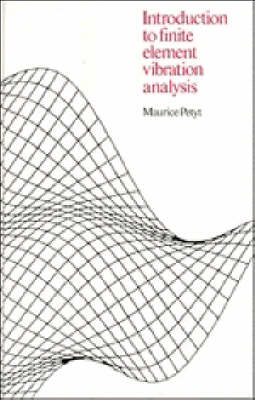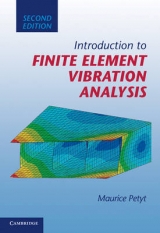
Introduction to Finite Element Vibration Analysis
Seiten
1990
Cambridge University Press (Verlag)
978-0-521-26607-9 (ISBN)
Cambridge University Press (Verlag)
978-0-521-26607-9 (ISBN)
- Titel erscheint in neuer Auflage
- Artikel merken
Zu diesem Artikel existiert eine Nachauflage
This book presents an introduction to the mathematical basis of finite element analysis as applied to vibrating systems, a technique which is very important in aeronautical, civil and mechanical engineering as well as naval architecture. The book has been written in a modular style to make it suitable for use in courses of varying length and level.
This book presents an introduction to the mathematical basis of finite element analysis as applied to vibrating systems. Finite element analysis is a technique which is very important in modelling the response of structures to dynamic loads and is widely used in aeronautical, civil and mechanical engineering as well as naval architecture. Commercial computer programs based on this technique already exist. Nevertheless, a knowledge of the mathematical principles involved is necessary before they can be successfully used. Therefore, this book assumes no previous knowledge of finite element techniques by the reader. The author has taught courses on the subject at both undergraduate and postgraduate levels. The book has been written in a modular style to make it suitable for use in courses of varying length and level.
This book presents an introduction to the mathematical basis of finite element analysis as applied to vibrating systems. Finite element analysis is a technique which is very important in modelling the response of structures to dynamic loads and is widely used in aeronautical, civil and mechanical engineering as well as naval architecture. Commercial computer programs based on this technique already exist. Nevertheless, a knowledge of the mathematical principles involved is necessary before they can be successfully used. Therefore, this book assumes no previous knowledge of finite element techniques by the reader. The author has taught courses on the subject at both undergraduate and postgraduate levels. The book has been written in a modular style to make it suitable for use in courses of varying length and level.
1. Formation of the equations of motion; 2. Element energy functions; 3. Introduction to the finite element displacement method; 4. In-plane vibration of plates; 5. Vibration of solids; 6. Flexural vibration of plate; 7. Vibration of stiffened plates and folded plate structures; 8. Analysis of free vibration; 9. Forced response I; 10. Forced response II; 11. Computer analysis techniques.
| Erscheint lt. Verlag | 12.4.1990 |
|---|---|
| Zusatzinfo | 245 Line drawings, unspecified |
| Verlagsort | Cambridge |
| Sprache | englisch |
| Maße | 152 x 228 mm |
| Gewicht | 970 g |
| Themenwelt | Technik ► Maschinenbau |
| ISBN-10 | 0-521-26607-6 / 0521266076 |
| ISBN-13 | 978-0-521-26607-9 / 9780521266079 |
| Zustand | Neuware |
| Haben Sie eine Frage zum Produkt? |
Mehr entdecken
aus dem Bereich
aus dem Bereich
Buch | Softcover (2023)
Springer Vieweg (Verlag)
CHF 34,95
Normung, Berechnung, Gestaltung
Buch | Softcover (2023)
Springer Vieweg (Verlag)
CHF 55,95
Buch | Softcover (2023)
Springer Vieweg (Verlag)
CHF 34,95



